Medical
Massage
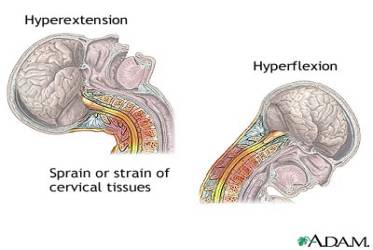
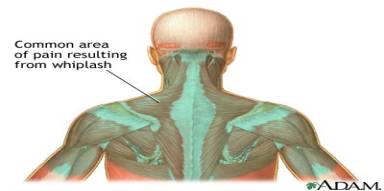
Whiplash
-Whiplash
is a broad term
used to refer to
many injuries,
including sprains,
strains and joint
trauma. Whiplash
injuries are
usually but not
always
associated with
car accidents in
which the head
whips forward
and backward in
rapid
succession.
-There
are many signs
and symptoms for
whiplash. More
sever cases
range from
ligament
sprains,
misaligned
vertebrae and
neuralgic
symptoms. Some
of the less
severe cases
would be
headaches,
muscle spasm and
trigger points.
-Massage
Therapy 48 hours
after the injury
can be very
helpful to
prevent or
reduce muscle
spasm, scar
tissue
accumulation,
adhesions, lack
of blood supply.
Carpal
Tunnel Syndrome
-Carpal
Tunnel Syndrome
(CTS) is a
diagnosis of
abnormal
pressure on the
median nerve in
the wrist as it
passes through
the carpal
tunnel.
Pain and
numbness or
tingling is
generally felt
in the thumb,
first two
fingers, and
palm area as
well as the
wrist.
In many cases
special forms of
massage therapy
such as
Neuromuscular
Therapy (NMT)
and Myofascial
Release (MFR)
can ease
pressure on the
nerve from
tendons passing
through the
carpal tunnel
and excess fluid
in the area.
-Massage therapy
can also help
relieve
conditions which
might mimic
Carpal Tunnel
Syndrome, or
referred pain
from muscles in
the arm or
shoulder.
Plantar
Fascitis
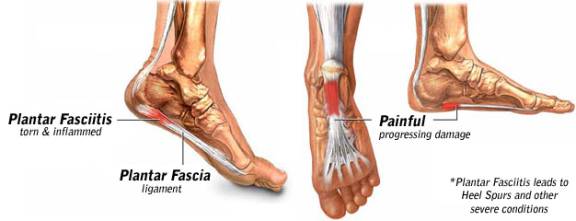
-Plantar
Fascitis is a
serious,
painful, and
progressing
illness that
occurs when the
long, flat
ligament along
the bottom of
the foot
develops tears
and
inflammation.
This ligament is
called the
plantar fascia
and it extends
your five toes
and runs along
the bottom of
your foot,
attaching to
your heel. When
you walk or run,
you land on your
heel and raise
yourself on your
toes as you
shift your
weight to your
other foot,
causing all your
weight to be
held up by your
plantar fascia.
Such repetitive
force can pull
the fascia from
its attachment
on your heel and
cause damage and
plantar
fasciitis.
-Massage
is indicated for
plantar fascitis.
It can
help release
tension in deep
calf muscles
that put strain
on the plantar
fascia. It can
also help to
affect the
development of
scar tissue at
the site of the
scar.
Sciatica
-Sciatica
is a severe pain
in the leg,
usually the back
of the leg,
caused by
compression or
irritation of
the nerve roots
exiting the
spine that form
the sciatic
nerve. The
sciatic nerves
are the largest
and longest
nerves of the
body, reaching
about the size
of your pinky or
forefinger in
diameter, formed
by four or five
nerve roots
branching off
each side of the
spinal cord and
down the back of
each leg. There
are also
conditions which
might mimic
sciatica and be
called
"false"
sciatica such as
Piroformis
syndrome where
the sciatic
nerve is
entrapped by the
piriformis
muscle in the
buttocks
area.
Piriformis
Syndrome is also
called
"back
pocket
sciatica"
because pressure
on the
piriformis
muscle and
sciatic nerve
can be caused by
sitting on a
wallet in the
back pocket of a
person's pants.
Another problem
that can mimic
sciatic pain is
having trigger
points in the
Gluteus Minimus
muscle.
The trigger
points in this
muscle can refer
pain sensations
down the back of
the leg along
the path of the
sciatic nerve
and also on the
outside of the
leg.
Massage therapy
and bodywork are
very beneficial
in relieving
symptoms and
promoting
recovery.
-Massage Therapy
can help
Sciatica,
Sciatic Nerve
Pain, and
conditions which
mimic sciatica.
Massage therapy
can help relax
muscles, release
trigger points
and abnormal
tissue
adhesions, and
improve posture
to relieve the
pressure on
nerve roots and
other sensitive
structures.
TMJ
Pain/Dysfunction
-Characterized
by pain in the
jaw, clicking
when opening or
closing the jaw,
headaches and
grinding of
teeth, TMJ
Dysfunction is
no laughing
matter.
Many things can
contribute to
TMJ Dysfunction
including
missing teeth,
trauma to the
jaw from
accidents or
sporting events,
stress, or even
postural
distortions.
-Massage
therapy, in
conjunction with
care by your
Dentist, can
relieve tension
and holding
patterns in the
muscles of the
head, neck, and
jaw to help
normalize jaw
function and
relieve pain.
Headaches
and
Migraines
What Are
Headaches and
Migraines?
-Headaches
are pain and
tension felt in
a person's head.
Most headaches
are related to
muscular tension
and trigger
points in
muscles which
can refer their
pain to various
points on the
head. The
headache pain
caused from
trigger points
are very real
and are
sometimes
resistant to
oral pain
relievers.
-Migraines
are a different
type of
headache.
Migraines are
thought by many
doctors to be
caused by
problems with
blood vessels
and nerves in
the brain.
Migraines are
characterized by
severe pain felt
on one side of
the head often
accompanied by
sensitivity to
light and
sometimes
nausea.
However, there
is also some
evidence that
even severe
migraines may be
caused by
muscular and
connective
tissue problems
that might
respond to
massage therapy
and bodywork.
|
Headache
and
Migraine
TrP's
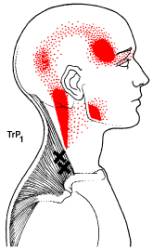
|
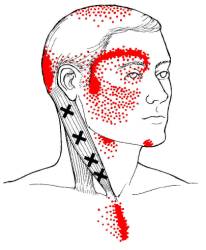
|
|
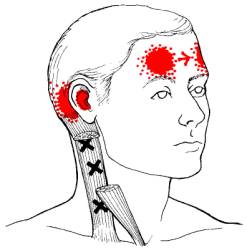
|
|
-In
the trigger
point
illustrations
above, the
"X" is
the approximate
location of the
trigger point
while the red
areas indicate
where the pain
is referred by
the trigger
point. The
darker red areas
are the most
commonly felt
and intense
areas of pain.
The lighter red
(stippled) areas
are those that
are less intense
or less commonly
felt.
These are just a
few of the
trigger points
which may cause
headache and
migraine pain -
there are more.
-Massage
Therapy is very
effective in the
treatment of
headaches and
some types of
Migraines.
Since the
majority of
headaches can be
traced to muscle
tension and
muscular trigger
points in the
head, neck, and
shoulders,
massage and
neuromuscular
therapy are
often able to
provide complete
relief. In
most cases the
massage would be
concentrated on
the upper body,
it is important
to know as a
client that the
posture of your
legs, hips,
pelvis, and back
can create the
tension that is
the root of your
headaches.
Therefore, a
full-body
approach to
treating your
headaches and
migraines is
usually best.
Arthritis
-While
there are
literally
hundreds of
different types
of
"arthritis"
the most common
is
osteoarthritis
which is
sometimes called
Degenerative
Joint Disease or
DJD.
-Osteoarthritis/DJD
occurs when the
cartilage in the
joint wears away
or is damaged by
trauma.
Muscles and
connective
tissues around
joints with mild
to moderate
osteoarthritis/DJD
tend to tighten
to support the
joint.
This tightening
is one of the
reasons
arthritis is
accompanied by
muscular pain.
-Massage
therapy is
usually
successful in
relieving
muscular pain
associated with
this type of
arthritis and
may even help
prevent further
breakdown of
joints.
Anxiety
-Anxiety
can be caused
from numerous
things and are
often
temporarily
relieved and may
be lessened in
the long term
with massage
therapy. This
was found to be
true especially
in persons
suffering
depression as
well as anxiety.
Tennis
elbow
-Tennis
Elbow is
actually
inflammation of
the tendons of
the wrist
extensor
muscles. Despite
the name, it is
suffered by
machinists,
mechanics,
golfers,
computer users
and even those
who carry heavy
briefcases to
work each
morning. During
the massage ice
might used to
help reduce the
inflammation in
the area.
Spasms
and cramps
-Spasms
and cramps are
involuntary
contractions of
skeletal
muscles. Spasms
are considered
to be low-grade
long-lasting
contractions,
where as cramps
are short-lived,
very acute
contractions.
-Cramps are
extremely
painful, with
visible
shortening of
the muscle. Long-term
spasms are
painful and may
cause
inefficient
movement, but
they may not
have acute
symptoms.
-Cramping
muscles do not
invite massage,
although
stretching and
work near the
muscles
attachments can
trick the muscle
into letting go.
Muscles that
have been
cramping respond
well to massage,
which can reduce
residual pain.
Massage is
indicated for
long-term spasm
because it can
break through
the cycle to
reintroduce
circulation to
the area, as
well as improve
muscle tone and
flush out
toxins.
Sprains
-Sprains are
injured
ligaments.
Injuries can
range few
traumatized
fibers to a
complete
rupture.
-Sprains
indicate
massage.
Bodywork
can reduce scar
tissue, swelling
and damage due
to a serve
sprain.
Strains
-Strains are
injuries to
muscles.
Pain
stiffness, and
occasionally
palpable heat
and swelling are
all signs of
muscle strain.
-Muscle strains
indicate
massage, which
can reduce scar
tissue,
adhesions,
edema, and
reestablish
range of motion.
|